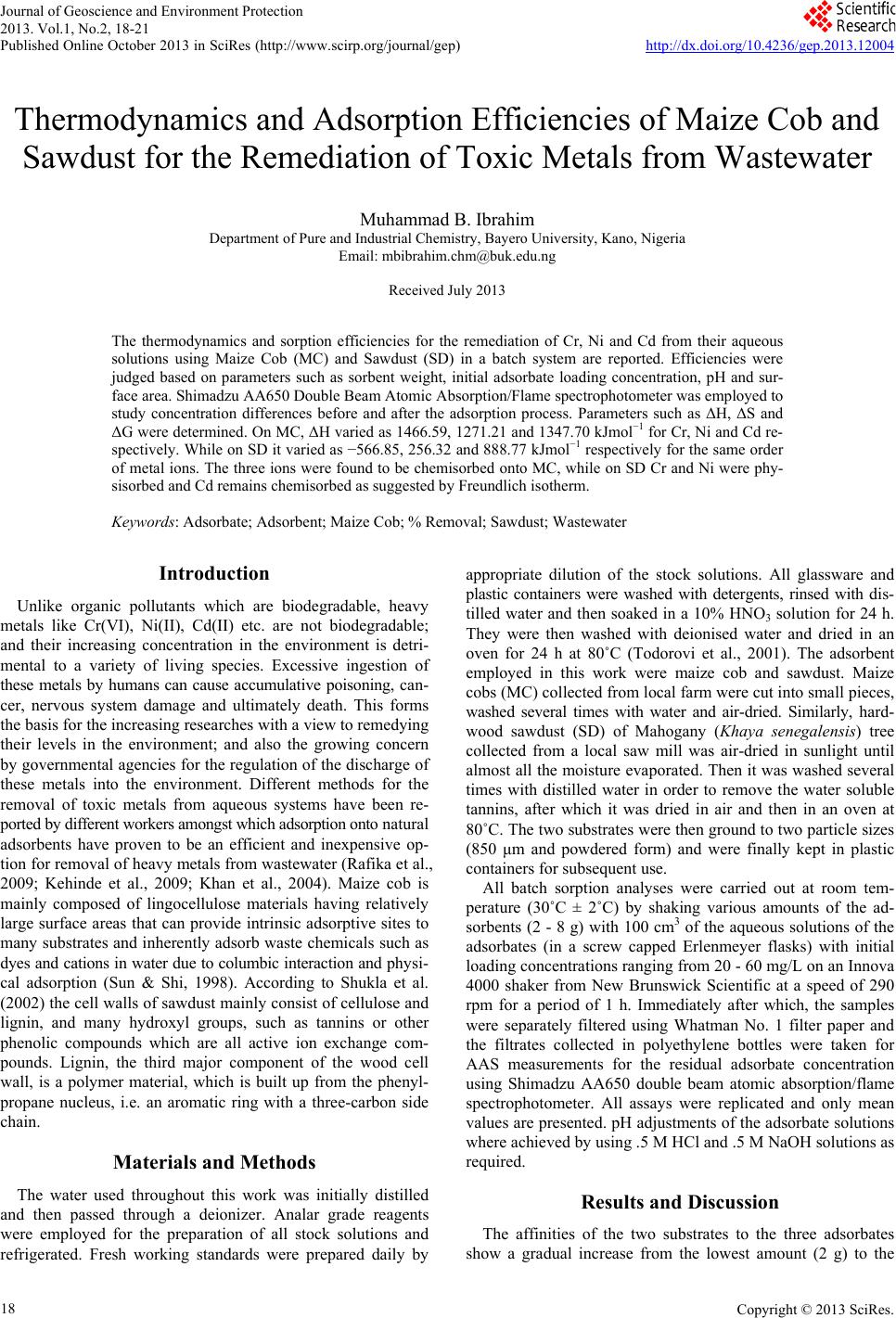
Journal of Geoscience and Environment Protection
2013. Vol.1, No.2, 18-21
Published Online October 201 3 in SciRes (http://www.scirp.org/journal/gep) http://dx.doi.org/10.4236/gep.2013.12004
Copyright © 2013 SciRes.
Thermodynamics and Adsorption Efficiencies of Maize Cob and
Sawdust for the Remediation of Toxic Metals from Wastewater
Muhammad B. Ibrahim
Department of Pure and Industrial Chemistry, Bayero University, Kano, Nigeria
Email: mbibrahim.chm@buk.edu.ng
Received July 2013
The thermodynamics and sorption efficiencies for the remediation of Cr, Ni and Cd from their aqueous
solutions using Maize Cob (MC) and Sawdust (SD) in a batch system are reported. Efficiencies were
judged based on parameters such as sorbent weight, initial adsorbate loading concentration, pH and sur-
face area. Shimadzu AA650 Double Beam Atomic Absorption/Flame spectrophotometer was employed to
study concentration differences before and after the adsorption process. Parameters such as ΔH, ΔS and
ΔG were determined. On MC, ΔH varied as 1466.59, 1271.21 and 1347.70 kJmol−1 for Cr, Ni and Cd re-
spectively. While on SD it varied as −566.85, 256.32 and 888.77 kJmol−1 respectively for the same order
of metal ions. The three ions were found to be chemisorbed onto MC, while on SD Cr and Ni were phy-
sisorbed and Cd remains chemisorbed as suggested by Freundlich isotherm.
Keywords: Adsorbate; Adsorbent; Maize Cob; % Removal; Sawdust; Wastewater
Introduction
Unlike organic pollutants which are biodegradable, heavy
metals like Cr(VI), Ni(II), Cd(II) etc. are not biodegradable;
and their increasing concentration in the environment is detri-
mental to a variety of living species. Excessive ingestion of
these metals by humans can cause accumulative poisoning, can-
cer, nervous system damage and ultimately death. This forms
the basis for the increasing researches with a view to remedying
their levels in the environment; and also the growing concern
by governmental agencies for the regulation of the discharge of
these metals into the environment. Different methods for the
removal of toxic metals from aqueous systems have been re-
ported by different workers amongst which adsorption onto natural
adsorbents have proven to be an efficient and inexpensive op-
tion for removal of heavy metals from wastewater (Rafika et al.,
2009; Kehinde et al., 2009; Khan et al., 2004). Maize cob is
mainly composed of lingocellulose materials having relatively
large surface areas that can provide intrinsic adsorptive sites to
many substrates and inherently adsorb waste chemicals such as
dyes and cations in water due t o columbic interaction and phy si-
cal adsorption (Sun & Shi, 1998). According to Shukla et al.
(2002) the cell walls of sawdust mainly consist of cellulose and
lignin, and many hydroxyl groups, such as tannins or other
phenolic compounds which are all active ion exchange com-
pounds. Lignin, the third major component of the wood cell
wall, is a polymer material, which is built up from the phenyl-
propane nucleus, i.e. an aromatic ring with a three-carbon side
chain.
Materials and Methods
The water used throughout this work was initially distilled
and then passed through a deionizer. Analar grade reagents
were employed for the preparation of all stock solutions and
refrigerated. Fresh working standards were prepared daily by
appropriate dilution of the stock solutions. All glassware and
plastic containers were washed with detergents, rinsed with dis-
tilled water and then soaked in a 10% HNO3 solution for 24 h.
They were then washed with deionised water and dried in an
oven for 24 h at 80˚C (Todorovi et al., 2001). The adsorbent
employed in this work were maize cob and sawdust. Maize
cobs (MC) collected from local farm were cut into small pieces,
washed several times with water and air-dried. Similarly, hard-
wood sawdust (SD) of Mahogany (Khaya senegalensis) tree
collected from a local saw mill was air-dried in sunlight until
almost all the moisture evaporated. Then it was washed several
times with distilled water in order to remove the water soluble
tannins, after which it was dried in air and then in an oven at
80˚C. The two substrates were then ground to two particle sizes
(850 μm and powdered form) and were finally kept in plastic
containers for subsequent use.
All batch sorption analyses were carried out at room tem-
perature (30˚C ± 2˚C) by shaking various amounts of the ad-
sorbents (2 - 8 g) with 100 cm3 of the aqueous solutions of the
adsorbates (in a screw capped Erlenmeyer flasks) with initial
loading concentrations ranging from 20 - 60 mg/L on an Innova
4000 shaker from New Brunswick Scientific at a speed of 290
rpm for a period of 1 h. Immediately after which, the samples
were separately filtered using Whatman No. 1 filter paper and
the filtrates collected in polyethylene bottles were taken for
AAS measurements for the residual adsorbate concentration
using Shimadzu AA650 double beam atomic absorption/flame
spectrophotometer. All assays were replicated and only mean
values are presented. pH adjustments of the adsorbate solutions
where achieved by using .5 M HCl and .5 M NaOH solutions as
required.
Results and Discu ssion
The affinities of the two substrates to the three adsorbates
show a gradual increase from the lowest amount (2 g) to the